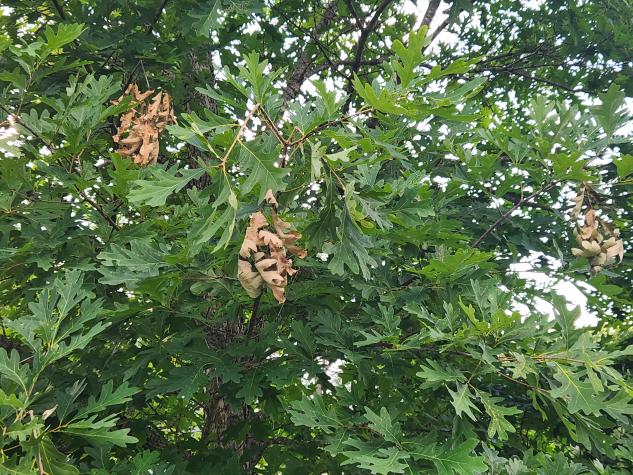Cicadas cause tree and shrub damage.
The cicada symphony may be coming to an end, but the effects of the performers are becoming apparent. Calls and emails are beginning to come into University of Missouri Extension offices from homeowners reporting the ends of many tree branches are turning brown and dropping off.
“In the past few days I have answered more than a dozen inquiries related to cicada damage,” said Hank Stelzer, MU Extension’s forestry state specialist.
Unlike their annual cicada cousins that emerge each year in July and August, adult periodical cicadas from Brood XIX have surfaced after living 13 years underground and are mating. The females then make narrow slits in the new twig growth.
“Females lay eggs in a series of slits in pencil-sized twigs in trees,” said Tamra Reall, MU Extension horticulture specialist. Each female can lay 400-600 eggs in total.
After 6-10 weeks, the eggs hatch and the new nymphs drop from the trees, burrow underground, locate a suitable tree root for feeding and begin their 13-year development.
“Cicadas use a wide variety of woody plants as a host,” Stelzer said. “They prefer apple, hickory, maple and oak trees. They also target birch, willow, linden and elm trees.”
Shrubs, including blueberry, rose, lilac and forsythia, may also be affected.
Conifers are rarely chosen since their needles impede egg laying and conifer sap can trap and kill eggs.
Tree impacts
Damage to trees occurs when female cicadas lay their eggs in small slits on twigs.
Heavily damaged twigs may droop and block water and nutrients from reaching the leaves beyond the point where the twig droops, resulting in yellowing or browning leaves, a phenomenon called “flagging.”
Some injured branches may not break off right away, but wounded areas will be weak sites that may eventually snap off in a summer storm or winter snow. “We will likely get reports over this year and into 2025,” Stelzer said.
In some cases, the wounds created by female cicadas may not heal and could serve as entryways for canker diseases or other problems that might affect tree health and lead to further twig death. But healthy, mature trees can better tolerate cicada twig damage and experience some harmless natural pruning.
It is not necessary to prune out any visible cicada damage on these larger trees, as dead twigs will fall off and larger branches are unaffected. For smaller, recently planted trees showing signs of cicada damage, it is best to consult a certified arborist to determine best course of action, Stelzer said.
Environmental benefits
Despite the “yuck” factor, decomposing periodical cicadas bring some benefits for trees and plants. Dead cicadas will decompose quickly; most of the cicada bodies will be gone within a couple of weeks. Wings and exoskeletons may stick around a little longer. Benefits of the periodical cicadas include:
- The nymph exoskeletons and adult carcasses can serve as natural fertilizer as they decay.
- Increased food supply for wildlife, especially birds that are currently raising their young.
- Soil aeration as the nymphs emerged from underground.
- Natural pruning of outer branches, which could lead to more lateral branches and possibly more flowers and fruit in the coming years.
Photos
Cicada damage
Cicada damage
Cicada damage to white oak tree branches. Photos by Hank Stelzer.
Writer: Julie Harker
